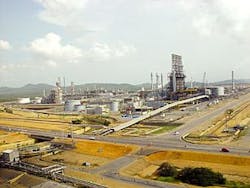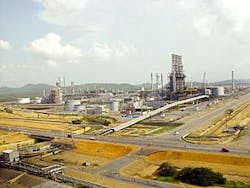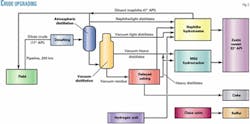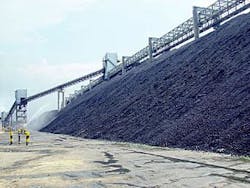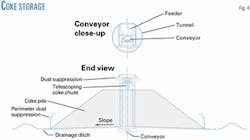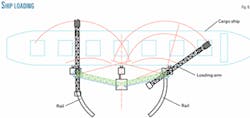Sincor begins exporting petcoke, sulfur from Jose crude upgrader
In late August 2002, Sincrudos de Oriente Sincor CA began exporting petcoke and sulfur from its just-completed offloading terminal adjacent its crude upgrader. Shot petcoke and liquid sulfur are two of the byproducts from Sincor's upgrader in Jose, Venezuela (OGJ, Oct. 29, 2001, p. 47).
The offloading facilities were officially inaugurated on Oct. 9, 2002.
The upgrader is part of a $4.2 billion integrated upstream and downstream project to produce products from the Orinoco heavy-oil belt. Two thirds of the investment was for the upgrader, storage, and export facilities. According to Sincor, the project was the biggest industrial investment ever made in Venezuela.
The Sincor fields can produce 200,000 b/d of an 8.5° API heavy crude. The project has a life of 35 years, which amounts to more than 2 billion bbl of available reserves.
The primary export product from Sincor is a synthetic, light, sweet crude called Zuata Sweet. After staring up the upgrader in December 2001, Sincor began exporting Zuata Sweet in March 2002.
In addition to the Zuata Sweet crude, Zuata Medium crude is available, which Sincor generates by blending Zuata Sweet with vacuum residue produced in the upgrader. Sincor shipped its first cargo of Zuata Medium to the US Gulf Coast in September 2002.
Sincor is a joint venture of TotalSA (47%), Petroleos de Venezuela SA (PDVSA, 38%), and Statoil ASA (15%).
Three other joint ventures are in Jose:
- Petrolera Ameriven, a joint venture among PDVSA (30%), ChevronTexaco Corp. (30%), and ConocoPhillips (40%).
- Cerro Negro, a joint venture of PDVSA (41.67%), ExxonMobil Corp. (41.67%), and Veba Oel AG (16.66%).
- Petrozuata, a joint venture of PDVSA (49.9%) and ConocoPhillips (50.1%).
Upgrader
The Sincor extra-heavy crude upgrader (Fig. 1) consists of a desalter, atmospheric distillation unit, vacuum distillation unit, naphtha hydrotreater, diesel hydrotreater, mild hydrocracker, and a delayed coker. The plant also includes utilities such as a hydrogen unit, water treatment, and sulfur recovery.
Table 1 shows unit design capacities, and Fig. 2 shows a flow diagram of all the Sincor facilities.
The upgrader takes the 8.5° API gravity crude and produces 32° API Zuata Sweet synthetic crude. It also produces petroleum coke (petcoke) and sulfur as byproducts.
Zuata Sweet (OGJ, July 16, 2001, pp. 52-54) has a sulfur content of about 0.12 wt %, which Sincor primarily markets to US Gulf Coast refiners.
The primary geographic markets for Zuata Sweet include refineries on the US Gulf Coast, East Coast, and Midcontinent, although the crude can be refined anywhere in the world.
The Sincor upgrader can typically produce:
- 180,000 b/d of Zuata Sweet and Zuata Medium crudes.
- 6,000 tonnes/day (tpd) of shot petcoke.
- 900 tpd of sulfur, in liquid or solid form.
According to Marketing Manager Graeme Burnett, Sincor has one long-term supply contract for Zuata Sweet with Valero Marketing & Supply Co. for 45,000 b/d. The remainder is sold on the spot market.
Zuata Medium is produced when economical and is sold on the spot market.
Primary units
Fresh crude feeds the atmospheric tower, which produces three main cuts: a naphtha diluent, a straight-run gas oil, and an atmospheric residue stream. Atmospheric residue flows to the vacuum tower, which separates the residue into three cuts: light vacuum gas oil, heavy volume gas oil, and vacuum residue.
The naphtha and diesel hydrotreater processes the lightest cuts, the mild hydrocracker processes the middle cuts, and the delayed coker processes the heavy cut.
The naphtha hydrotreater and atmospheric distillation unit produce 70,000 b/sd of a 47° API naphtha stream that is sent to the San Diego production station and mixed with the raw crude. The 17° API mixture is sent to the Jose upgrader via a 200-km pipeline.
The 284,000-b/sd atmospheric distillation unit's main tower is 57 m tall and weighs 300 tonnes. The 176,000-b/sd vacuum distillation unit's tower is also 57 m tall but weighs 900 tonnes. The vacuum tower was transported in one piece from South Korea.
Institute Français du Pétrole, Paris, designed the naphtha hydrotreater and mild hydrocracker.
The hydrogen production unit is a steam-methane reformer designed by Krupp Uhde GMBH. The unit produces a hydrogen stream with a 99.99% purity.
Delayed coker
The Sincor delayed coker is the heart of the upgrader.
The 89,000-b/sd coker (corresponding to a 19-hr cycle) was designed and built by Foster Wheeler USA Corp. The unit, which consists of six 28-ft ID coke drums, is the second largest in the world, according to Sincor.
The unit's rated capacity is 106,800 b/d of fresh feed with a 16-hr cycle time. The coker includes a number of safety systems to reduce operational risks and automate drum switches.
The drum sequencing is programmed into a digital control system. No manual operations are involved in opening the drums' bottom valves.
The coker towers are 105 m high.
Petcoke markets
According to Burnett, Sincor's upgrader produces 4% of the world's petcoke. Because the volume of petcoke is so large and it is not Sincor's core business, long-term agreements were negotiated with third-party marketers with international experience in petcoke handling and marketing.
Sincor sells 50% of its coke to TCP Petcoke Corp., New York, which is a joint venture between Citgo Petroleum Corp. and RWE Rheinbraun AG. Citgo is owned by PDVSA, one of the shareholders in the Sincor project.
The other 50% of the coke is sold to the SSM Petcoke LLC, which became a wholly owned subsidiary of RWE AG in 2001. RWE AG also owns RWE Rheinbraun AG.
The contracts with SSM and TCP require the marketing companies to sell only to end-users meeting the highest environmental standards.
Sincor's petcoke quality is not high enough for use as needle petcoke but is used for electricity generation as a substitute for coal and in the cement industry. The cement industry consumes more than 60% of the world's annual production of petcoke.
According to Burnett, Sincor's coke contains about 4.5% sulfur, which compares favorably to coal. The petcoke also has a higher Hargrove grindability index, which means that it is softer than the coal and therefore easier for end users to process.
Sulfur markets
The Sincor sulfur has a purity of 99.9%, according to François Badoual, business manager for the Sincor project, and is normally sold in liquid form.
Similar to the petcoke product, sulfur is not a core business for Sincor. The sulfur is sold to end-users through third-party marketers Shell Canada Ltd. and International Commodities Export Corp. The principal market for sulfur is in the production of fertilizers. According to Burnett, liquid sulfur has only two outlets, Florida and Tunisia. Sincor, therefore, wanted to have the flexibility to produce sulfur in both liquid and solid form.
Offloading facilities
As stated, Sincor officially inaugurated its offloading facilities on Oct. 9, 2002. The solids storage and terminal facilities cost $265-270 million, according to Adlaberto Arias, upgrader manager.
A third party operates the storage, conveyor, and offloading facilities. Again, Sincor did not want to operate the facilities because this was not a core competency.
The operating company, Aimvenca, is a joint venture between Aimcor and a Venezuelan maintenance company. Aimvenca has a 12-year contract with Sincor based on performance criteria and demurrage.
Fast-track schedule
Originally, Sincor planned to load its petcoke and sulfur into ships using Petrozuata's jetty facility.
According to Hugo Gamboa, project engineer, the two parties could not come to an agreement by mid-2000; therefore, Sincor was faced with the predicament of building its own offloading facilities.
Gamboa said that Sincor had roughly 18 months to complete the project because the upgrader was starting up in December 2001 and coke was scheduled for export in mid to late 2002.
According to Juan Jose Losada, project engineer, this was not enough time to build a new jetty because the permits alone take 8-12 months. Sincor, therefore, asked Pequiven SA to share its product jetty. Pequiven agreed, with the stipulation that Sincor not contaminate Pequiven's urea product.
Another factor complicating the situation was that Sincor had not completely finished the coke storage facility. For temporary storage, Sincor quickly constructed a radial stacker while the permanent facility was completed.
To expedite the overall project, Sincor engineers separated it into stages: petcoke and sulfur storage, delivery to the jetty, movement along the jetty, and ship-loading facilities.
The project also had a requirement that the design selected be completed in the allotted time period with little chance of delays. If a significant delay occurred, the alternative could have possibly been to shut down the upgrader.
Product storage
Sincor began storing petcoke in March 2002, before the jetty facilities were even finished. The storage facility has a capacity of 1 million tonnes of petcoke. Sincor required that the facility be built in less than 14 months in a limited plot area.
Sincor accepted the project bid from River Consulting Inc., Metairie, La., which had built a similar system for coal storage in Virginia.
The storage facility (Fig. 3) is 40 m high, 450 m long, and uses a shuttle conveyor supported in a concrete truss. Telescoping discharge chutes minimize petcoke dust.
Petcoke is discharged from the storage facility via an underground tunnel (Fig. 4), which contains the first part of the conveyor system to the jetty. Removing coke from the bottom of the pile also helps minimize coke dust formation.
The 26 "feeders" into which the coke falls also have vibration systems that help shake the coke on to the conveyor. Any remaining coke outside the holes is moved with bulldozers. Three feeders can be used at one time.
The petcoke inventory is also sprayed down with water periodically to prevent dust formation. Runoff from these activities is collected in a drainage ditch that surrounds the petcoke pile. The runoff is then sent through a 26,000 cu m settling pond, which collects coke particles for later reclamation by Sincor.
Additionally, according to Gamboa, the water spray system can incorporate surfactants that create a "layer" on the petcoke pile. This also helps reduce coke dust.
The facilities can also store 90,000 tonnes of solid sulfur and 45,000 tonnes of liquid sulfur. The liquid sulfur is stored in three heated tanks.
Conveyor transportation
The conveyor from the delayed coker to the petcoke storage facility has a capacity of 1,600 tonnes/hr (tph). Fig. 1 shows that this conveyor was built under the main road.
Petcoke from the storage facility moves to the product jetty via an enclosed conveyor belt system that can handle up to 2,000 tph. It also has a water-spray system to suppress petcoke dust.
The conveyor from the petcoke pile to the jetty is 3 km long and contains a water-spray system.
As previously mentioned, the jetty also transports urea from Pequiven. Urea, a white powder, can easily be contaminated by any coke dust present.
According to Gamboa, the solution to this problem was to use a flat conveyor system, which forms itself into a tube.
The conveyor opens for loading and unloading yet is a completely sealed tube between the two locations.
The hard rubber conveyor contains metal bars that force the rubber into its tube structure. Rollers at the loading and unloading locations force the conveyor into a flat shape.
According to Alert Gaard, project manager for the petcoke and sulfur-handling project, the tube overlap is about 40%, which ensures an exceptional seal. This tube system runs for 1 km along the jetty.
The tube velocity is adjusted so the tube contains at least 60% petcoke, Gaard said.
Because Pequiven's urea conveyor uses a similar system, contamination from the petcoke is highly unlikely.
Liquid sulfur is transported to the jetty via a 16-in. diameter pipeline that has steam tracing to keep the sulfur liquefied.
Solid sulfur is transported along the same conveyor system. Switching between products requires 18-24 hr of washing the conveyors to ensure product purity.
Ship loading
According to Gaard, given the storage capacity of 1 million tonnes and the upgrader producing 6,000 tpd gave Sincor roughly 5 months to complete the jetty facilities.
Gamboa said that Sincor conducted a worldwide survey of petcoke loaders and no existing design could handle the rate required. Sincor wanted to load ships at 2,000 tph; existing designs had a maximum of 500 tph.
The project engineers contacted River Consulting to come up with an acceptable design. River Consulting had a patented system that could handle this loading rate, but they had not built one.
The first-of-its-kind design uses a dual orbiting loader (Fig. 5) to move the petcoke into ships. The advantage of this design is that the ship does not have to move during the loading procedure; the dual arm is configured to reach all cargo bays.
Fig. 6 shows a diagram of the loader. The loader has two double-hinged arms; the middle hinge moves along a curved track.
Sincor attained the design ship-loading rate of 30,000 tpd on the second ship, according to Arias. He also said that a rate of 40,000 tpd was recently attained.
The sulfur loading arm has a capacity of 840 cu m/hr.
Environment, safety, labor
The project design's primary priorities were to protect the surrounding environment and worker health, according to Gamboa. The area for petcoke storage was relatively small and close to a creek.
Sincor's goal, therefore, was to have zero discharges to the surrounding area. The coke recovery and water spray systems ensured the meeting of this goal.
During the entire project, Sincor defined policies and principles that would guarantee the safety of its staff and contractors. In addition to zero discharges, Sincor had the goal of zero accidents.
At the peak of the project, it employed 1,400 workers who worked 4.1 million man-hr.
